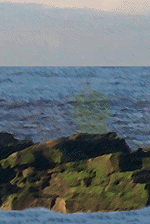
Tom Hurd Rock lies just to the South of West Pier. It is fully exposed at low tide and just about covered by the high tide. Quite possibly in the past it was more prominent as sand has built up around it, and the name certainly dates back to at least the 17th century, as it is often mentioned in the correspondence of Sir John Lowther. The melancholy story of how it got its name and apparently passed down by word of mouth until published by Joseph Weir in 1910 is as follows:-
Tom Hurd was a sailor on leave from the Navy to see his sweetheart Eliza. He was a spirited and jovial young man much liked. At a time when Parton was a port comparable with Whitehaven the locals often used to spend a day out there, either walking along the wagon road or taking a small boat and sailing along the coast. For this purpose Tom and Eliza along with her brother took a rowing boat and had lovely trip in the calm seas on a sunny morning. At Parton they spent several hours in a hospitable tavern oblivious to the changing weather outside as they chatted away enthralled by each others company and sustained by refreshments.
It was late in the afternoon, when Eliza persuaded Tom that the seriousness of the weather gave them cause to head for home straight away. Despite the strong winds and increasing waves the two young men felt that they could still get home in the boat and with Eliza sat at the stern rowed for home. The weather continued to worsen but the wind did change in their favour and gave them optimism to make a landing at Whitehaven. However, just off the Bransty cliffs the storm let loose its full fury and violently thrashed the little boat. As they reached the mouth of the harbour, which at that time only reached as far as the Old Quay, Tom Hurd's ore snapped in two. With only one oar control became impossible and Tom sat hanging on to his beloved Eliza in the stern.
People on shore noticed the trouble and crowds started to gather but were unable to do anything but watch the perilous situation unfold before them. It was hoped that the boat may be tossed onto the beach by the mountainous waves but then suddenly it was thrown at the rocks by a huge wave. As the wave subsided the crowd could see Tom clambering onto the rock with Eliza hanging limply in his left arm. For hours the crowd had to watch as he sat there hugging her. Eventually, the tide receded and some men were able to get to the rock. They found Tom, almost lifeless and Eliza worse having had her left temple smashed on the rock. Her brother was later found washed up on shore, drowned.
For weeks Tom fell in and out of consciousness but although he was nursed by friends back to some physical strength his loss destroyed his spirit and he used to walk alone along the beach. Despite pleas from his friends he would often sit on the rock especially during bad weather looking out to see as the tide came in and then went out again. One night there was a terrible storm and people realised Tom was missing, when they got to the rock they found it completely covered by an exceptionally high tide. His body was found washed into a recess under the cliffs.
Ever since the rock has his name.

If you are a romantic stop reading now.
If you are a historian there are problems with authenticating this story. Tom was supposedly in the Navy of King William. Now we know the rock was called Tom Herd by William Gilpin in his letter to John Lowther in 1693 - this makes it far too early to be William IV who ruled from 1765. However, William III (of orange) ascended to the throne in 1689 and the war in Ireland followed which Whitehaven was involved in by shipping troops over there and bringing Protestant refugees back. A sketch map of Whitehaven dated in Daniel Hay's book shows the rock as Tom Herde Rocks. Daniel Hay dates this as c1693 but the more recent book by the Royal Commission on the Historical Monuments of England dates it as c1690. That date makes it very difficult for Tom Hurd to serve in the Irish War of 1690 get back and nearly drown once, go back and finish the job months later, become part of folklore have the rock named after himself and have it named so on a map of the same year. Also I have a note that the name came from the words DOM HEREDES, meaning Lord and Heirs, on a 14th century plan showing the boundary of lands, which just happened to be near the rock.
This might be re-enforced by the change in spelling
Tom Hurd Rock - present day
Tom Herds Rock - 1815
Tom Herds Rocks - 1770
Tom Herde Rocks - 1690
It is such a good story though it's hard to imagine that such an incident didn't happen
and maybe the lad was called Tom and maybe the connection stuck.
© WAWL 2006